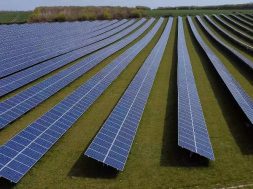
Solar cells can be made cheaper: Richard Corkish
Keen to partner Indian firms that will mass manufacture, says UNSW researcher
Researchers at Australia’s University of New South Wales led by Dr. Richard Corkish, COO, Advanced Photovoltaic Centre, recently set a new world record for solar cell efficiency by developing the largest single perovskite photovoltaics cell, which is 10 times bigger than the current certified high-efficiency perovskite solar cells. This invention is expected to transform many existing solar applications including disaster response, device charging and lighting villages which are without electricity. In an interview, Dr. Corkish, who has been working in photovoltaics research and education at UNSW since 1990, discusses the new technology and how it could benefit India.
When will your technology reach the market?
Well, we are talking about two technologies. The hydrogenation is already happening. UNSW has a number of industry partners who are already putting in serious money for research. Some of it is happening with Chinese companies that are interacting with us through a technology park that is established in Australia with UNSW.
It is a Chinese government-sponsored research and technology development centre. This is the first one that is established with China. But our partners are not exclusively Chinese. We are in discussion with at least one Indian company. As far as I know, we haven’t signed a contract yet.
We are very conscious of India being a huge market; it has huge potential. It can leapfrog into generating lots of sustainable electricity.
The other technology of focus is the perovskite. It is uncertain whether we will find a market for this. I think the most likely market is as a material on top of silicon and I think that’s not going to happen until we really extend the stability of the material. Because, it doesn’t make any sense to put something that lasts for one year upon something that lasts for 20 years. So, we need to find a way around that and there are certainly ideas for that and people are investing in a lot of ways.
How will India benefit from your inventions?
India has potential for establishing manufacturing here. There could be massive manufacture of silicon solar cells and corporates getting into hydrogenation technology and using the PRC technology that has been developed years ago at UNSW. Together, we can make solar cells cheaper. I think if companies are establishing new production lines in India for silicon solar cells, that will have a long path to go.
It remains tough, to compare with other countries if they have already had a head start. Countries that are currently dominant in solar cell manufacturing in the world have a good running head start so it is hard to catch up with them. China is one such country but there have been others such as Korea and Taiwan which have a longer history as mass manufacturers. But India certainly has mass manufacturers. Tata and BP Solar had 2 or 3 factories in Bangalore years ago as a joint venture. BP pulled out but the Tatas are continuing.
We are in discussion with one Indian company. Those planning to go into serious mass manufacturing of silicon solar cells in India can partner with us. We want to support the Indian people as consumers of solar cells as most of them in villagers are still living without electricity. At the other end, we want to make better solar cells to support manufacturers.
How has the price of solar cells decreased over the years? How will your invention help?
I think it is likely to continue at the rate of decrease witnessed over the years. I don’t remember the exact numbers. Our changes will help that decrease. We just need continual improvement. This decrease has happened over years. Scaling up of manufacturing units, making more solar cells in factories have made it cheaper.
What does your research say on the forecast? Where are we likely to go?
We don’t do research on the market scale. But it is not so hard to predict the future. I think nobody expects solar cell to be the only player in the game. Solar thermal, solar water heaters and perhaps even solar thermal for high temperature for industrial use like electricity is another technology that works but is a little bit expensive.
Passive solar is another one. We are sitting in our air conditioned building with the sun pouring in through the windows. This is not a good example of solar. We need to build buildings that will stay cooler in summer and warmer in winter. We know how to do this and we need regulatory control and the willingness to do it. In fact, the ancient Greeks knew this. This is not a new technology.
Will solar be the cheapest source of energy?
It is not the cheapest everywhere. In many places, it is cheaper. If the sunshine is not good, then the wind makes more sense but overall, it has consistently decreased in cost over many, many years. We have to do things that have low carbon impact. Solar cells are one of those.
We have other technologies like nuclear technology. The learning curve in nuclear technology is negative. It gets more expensive with time.
This is because we build in more safety and security due to accidents we have come across. So it costs more.
There is a lot of resistance to nuclear technology.
Yes. In Australia, we don’t have any nuclear power generation. It is more expensive than solar. We will never have it in Australia. Some countries in the world have fewer choices.
India or Australia have huge and sunny lands but other small countries don’t really have many choices. But the nuclear path is [getting] increasingly expensive but now we have other alternatives.















